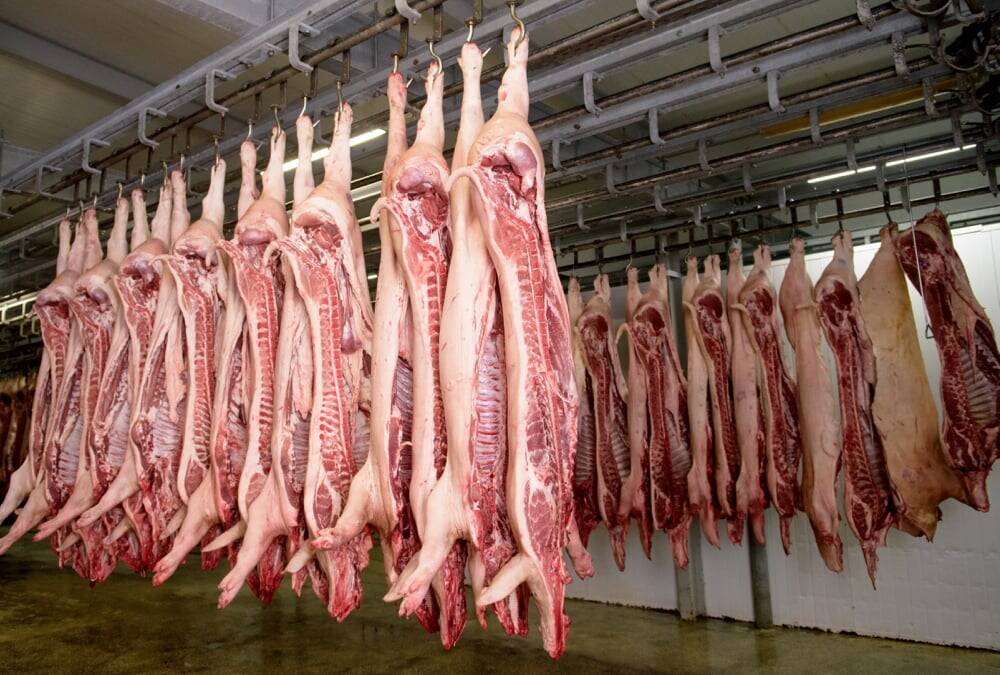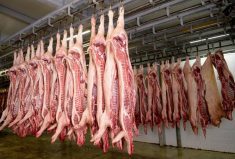Nearby lean hog futures prices have declined 18 per cent since mid-August.
The Labour Day weekend traditionally signifies an end to the summer barbecue season, and with packers having satisfied their short-term needs, the resulting reduction in demand is partially responsible for the seasonal downturn in prices. Also weighing on the market is not only the fact that producers are increasing their deliveries of market-ready hogs, but that these slaughter animals are coming in heavier than normal.
Lean hog futures contracts at the Chicago Mercantile Exchange (CME) exemplify a strong seasonal tendency for lean hog prices to turn down after the August futures contract expires.
Read Also

U.S. livestock: Lean hogs tick down on supply numbers, year-end positioning
Chicago | Reuters – Chicago Mercantile Exchange live cattle and lean hog futures fell while feeder cattle futures rose on…
On Aug. 14, the August 2013 futures contract posted a new contract high and expired at $102.425 per hundredweight (cwt). The following day, the October 2013 futures contract became the nearby contract, which opened at $88.225/cwt and then declined five per cent over the ensuing five trading days to $83.80 (all figures US$).
Prior to this price decline, the charts gave early indications of an impending downturn. Amid bullish news of the cash market leading the futures higher, on July 31 a two-month reversal developed on the monthly nearby lean hog futures chart at the CME. This is a reversal pattern that indicates a market is about to change direction and forewarned of an impending downturn in the market.
Two-month reversal
On the first month, at a top, the market advances to new highs and closes very strong at or near the high of the day. The following month, prices open unchanged to slightly higher, but can’t make additional upside progress. Quantity selling appears early in the month to halt the advance, and prices begin to erode.
By month’s end, the market drops to around the preceding month’s low and closes at or near that level. For a two-month reversal to be valid, the second month’s settlement price must be below the mid-point of the previous month’s opening and closing price.
Market psychology: The two-month reversal is a 180-degree turn in sentiment. On the first month the longs are comfortable and confident as the market closes higher. The market’s performance provides encouragement and reinforces the expectation of further gains.
The second month’s activity is psychologically damaging as it is a complete turnaround from the preceding month and serves to shake the confidence of many who are still long the market. The immediate outlook for prices is abruptly put in question. The longs respond to weakening prices by exiting the market. At first the “smart money” sells to take profit, while others eventually sell to cut their losses. This action is referred to as long liquidation.
In this scenario a market tends to erode until the long liquidation is over — often ignoring bullish news. The exodus of market participants and the flow of money leaving the market sometimes causes prices to go down further and stay down longer than most in the trade would have first anticipated.
As illustrated in the accompanying chart, after the two-month reversal developed at the end of July, prices remained up near the high during the first couple of weeks in August, providing opportunity for livestock producers to take advantage of the sell signal provided by the two-month reversal.
The U.S. Commodity Futures Trading Commission (CFTC) releases Commitments of Traders (COT) reports each Friday afternoon. These weekly reports provide a snapshot or breakdown of each Tuesday’s open interest.
This report reveals large speculators are currently holding a record-long futures position and the commercials have a record-short futures position in lean hogs. Therefore, traders and livestock producers should be aware: the unwinding of the October 2013 futures contracts leaves the lean hog futures market susceptible to extreme volatility in the weeks ahead.
Send us your questions or comments about this article and chart.
— David Drozd is president and senior market analyst for Winnipeg-based Ag-Chieve Corp. The opinions expressed are those of the writer and are solely intended to assist readers with a better understanding of technical analysis. Visit Ag-Chieve online for information about grain marketing advisory services, or call us toll-free at 1-888-274-3138 for a free consultation.














